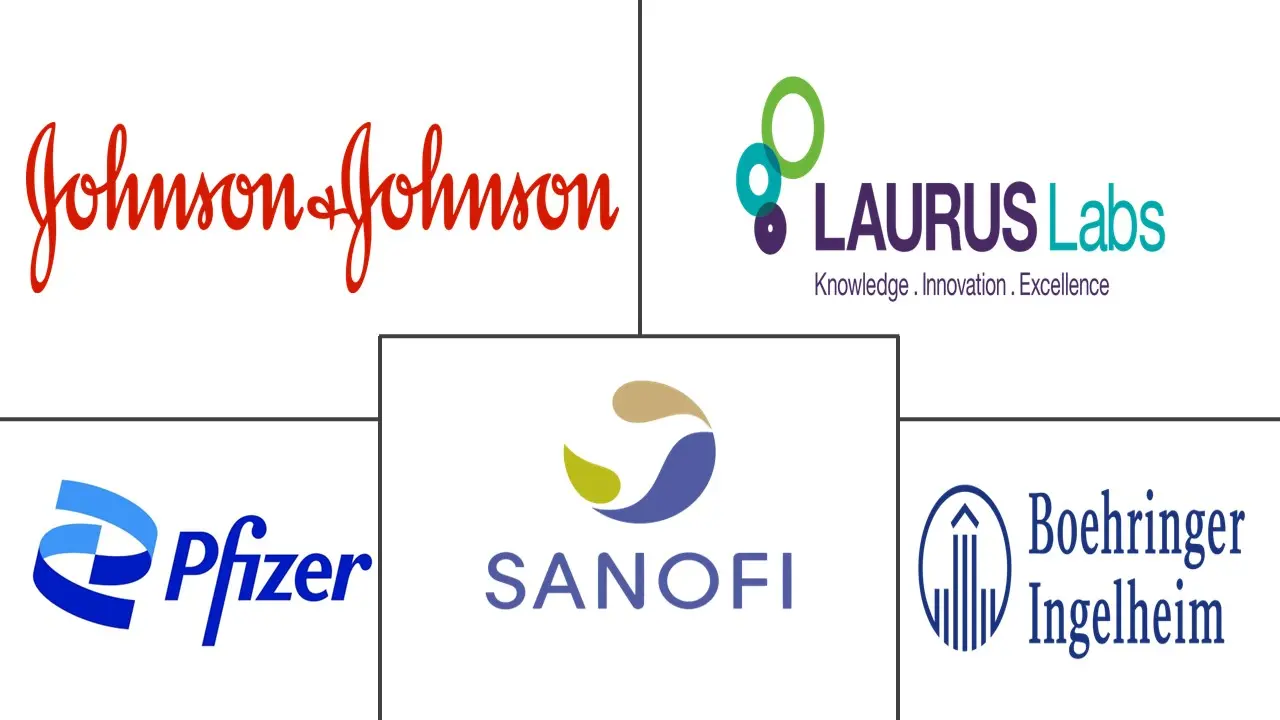Thrombosis Drugs Market Size and Share
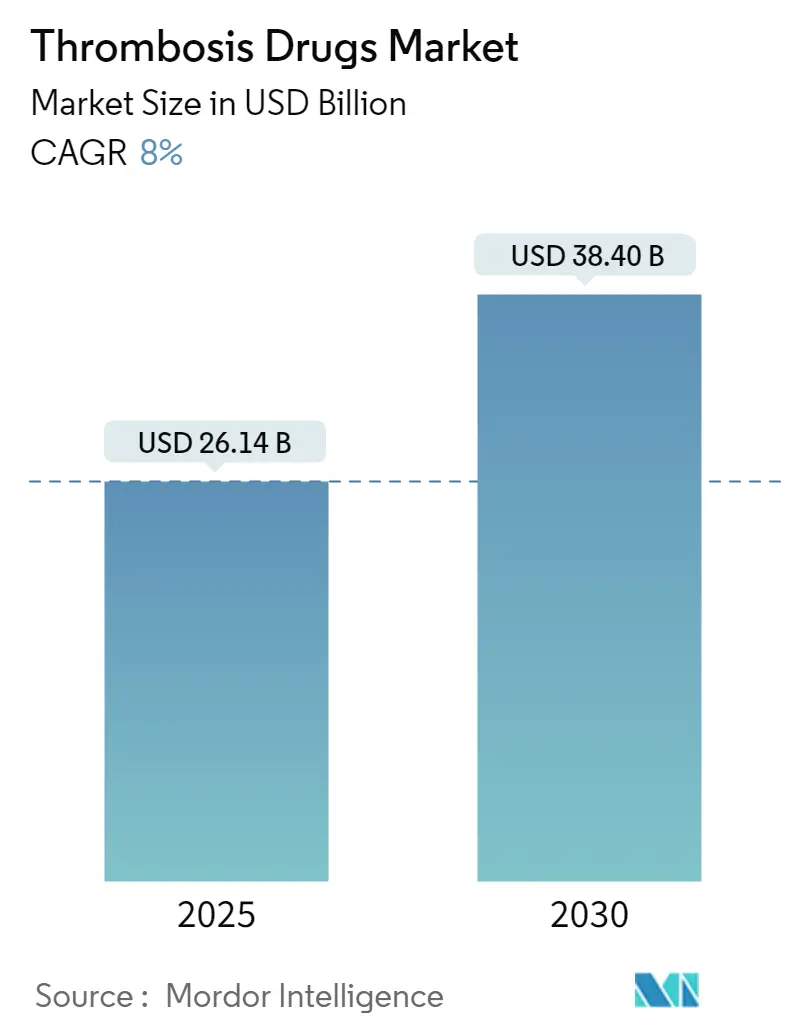
Thrombosis Drugs Market Analysis by Mordor Intelligence
The thrombosis drugs market size stands at USD 26.14 billion in 2025 and is projected to attain USD 38.40 billion by 2030, advancing at an 8.0% CAGR during the forecast period. Expanded life expectancy, rising venous thrombo-embolism (VTE) incidence, and accelerated adoption of direct oral anticoagulants (DOACs) are underpinning steady demand. Regulatory green lights for first-in-class Factor XI inhibitors, together with artificial-intelligence risk stratification tools, are recasting therapy selection beyond warfarin and heparin. Hospitals continue to favor rapid-onset injectables for acute care even as outpatient use of once-daily oral DOACs becomes the routine standard. Competitive responses to approaching patent cliffs include consolidation around safer mechanisms of action and discount programs aimed at sustaining loyalty during the shift from brands to generics.
Key Report Takeaways
By drug class, DOACs captured 55.1% of thrombosis drugs market share in 2024, while Factor XI inhibitors are projected to expand at an 8.61% CAGR through 2030.
By disease type, deep-vein thrombosis led with 31.81% share of the thrombosis drugs market size in 2024; pulmonary embolism is set to grow at an 8.43% CAGR by 2030.
By route of administration, oral products commanded 67.3% of the thrombosis drugs market size in 2024, whereas injectables are forecast to grow at 8.26% CAGR through 2030.
By geography, North America held 38.2% of thrombosis drugs market share in 2024; Asia-Pacific is the fastest-growing region at 7.93% CAGR to 2030.
Global Thrombosis Drugs Market Trends and Insights
Driver Impact Analysis
| Driver | (~) % Impact on CAGR Forecast | Geographic Relevance | Impact Timeline |
|---|---|---|---|
| Rising venous thrombo-embolism (VTE) prevalence | +2.1% | Global, with concentration in aging populations of North America & Europe | Long term (≥ 4 years) |
| Rapid adoption of direct oral anticoagulants (DOACs) | +1.8% | North America & Europe leading, Asia-Pacific following | Medium term (2-4 years) |
| Growing surgical volumes & peri-operative prophylaxis need | +1.4% | Global, driven by Asia-Pacific healthcare expansion | Medium term (2-4 years) |
| Pipeline of Factor XI inhibitors promising lower bleed risk | +1.2% | North America & Europe early adoption, global expansion | Long term (≥ 4 years) |
| COVID-triggered protocols for inpatient thromboprophylaxis | +0.8% | Global, with persistent impact in hospital systems | Short term (≤ 2 years) |
| Expansion of AI-based risk stratification enabling targeted therapy | +0.6% | North America & Europe leading, selective Asia-Pacific adoption | Long term (≥ 4 years) |
| Source: Mordor Intelligence | |||
Rising VTE prevalence
Higher life expectancy and a surge in cancer survival elevate VTE incidence, making long-term anticoagulation an essential component of chronic disease care. Lung-cancer patients face pulmonary-embolism rates roughly six times the population baseline, creating durable demand for safer oral agents[1]Source: Zhang Yi-Wen et al., “Research progress on the association between lung cancer and pulmonary embolism,” Journal of Cardiothoracic Surgery, journal.cardiothoracsurg.com . Hospitals respond by embedding thrombosis protocols within oncology pathways, shifting anticoagulation from episodic to continuous management.
Rapid adoption of DOACs
Evidence from ROCKET-AF and ARISTOTLE continues to drive prescriber confidence in rivaroxaban and apixaban. Bristol Myers Squibb and Pfizer recorded USD 3.2 billion in Eliquis sales in Q4 2024. Upcoming Medicare-negotiated prices effective January 2026 lower patient out-of-pocket costs, broadening eligibility without compromising margins.
Growing surgical volumes & peri-operative prophylaxis
Elective and trauma surgeries are rising fastest in Asia-Pacific, where low-molecular-weight heparins (LMWHs) cut hospital stays from 3.3 to 2.4 days in atrial-fibrillation cases. Outpatient same-day procedures heighten the need for predictable injectables that bridge surgery with outpatient prophylaxis.
Expanding pipeline of Factor XI inhibitors
Abelacimab reduced major or clinically relevant bleeding by 67% versus rivaroxaban in Phase II studies[2]Source: Anthos Therapeutics, “Abelacimab 150 mg Demonstrated 67% Bleeding Reduction,” Anthostherapeutics.com . Novartis secured the candidate through a USD 925 million acquisition that underscores industry intent to leapfrog DOAC safety limits.
Restraint Impact Analysis
| Restraint | (~) % Impact on CAGR Forecast | Geographic Relevance | Impact Timeline |
|---|---|---|---|
| High cost of novel anticoagulants | -1.5% | Global, with acute impact in price-sensitive emerging markets | Medium term (2-4 years) |
| Patent expiries & generic erosion | -1.2% | North America & Europe primarily, spreading to global markets | Short term (≤ 2 years) |
| Safety concerns – major bleeding & limited reversal agents | -0.9% | Global, with regulatory focus in developed markets | Long term (≥ 4 years) |
| Source: Mordor Intelligence | |||
High cost of novel anticoagulants
List prices often dwarf those of warfarin, curbing uptake in price-sensitive regions. Bristol Myers Squibb and Pfizer now sell Eliquis direct to patients at 40% discount, dropping monthly costs to USD 346. Policy shifts such as Medicare negotiations suggest broader price pressure is imminent.
Patent expiries & generic erosion
FDA approval of generic rivaroxaban in March 2025 precipitated a 31% drop in Bayer’s Xarelto sales during Q1 2025. Similar erosion looms for Eliquis in 2028, forcing innovators to migrate portfolios toward next-generation assets.
Segment Analysis
By Drug Class: DOAC dominance alongside Factor XI momentum
DOACs yielded 55.1% thrombosis drugs market share in 2024 and represent a USD 14.4 billion slice of the thrombosis drugs market size, expanding on the back of simplified dosing and fewer monitoring demands. Factor XI inhibitors are forecast to climb at an 8.61% CAGR, converting bleeding-averse clinicians and patients.
Heparin and LMWHs sustain relevance for in-patient bridging and oncology protocols. Vitamin K antagonists retreat to resource-limited settings, while thrombolytics retain niche roles in stroke and massive pulmonary-embolism emergencies. The arrival of once-monthly subcutaneous Factor XI agents could blur traditional oral-versus-injectable boundaries, recasting competitive alignment within the thrombosis drugs market.
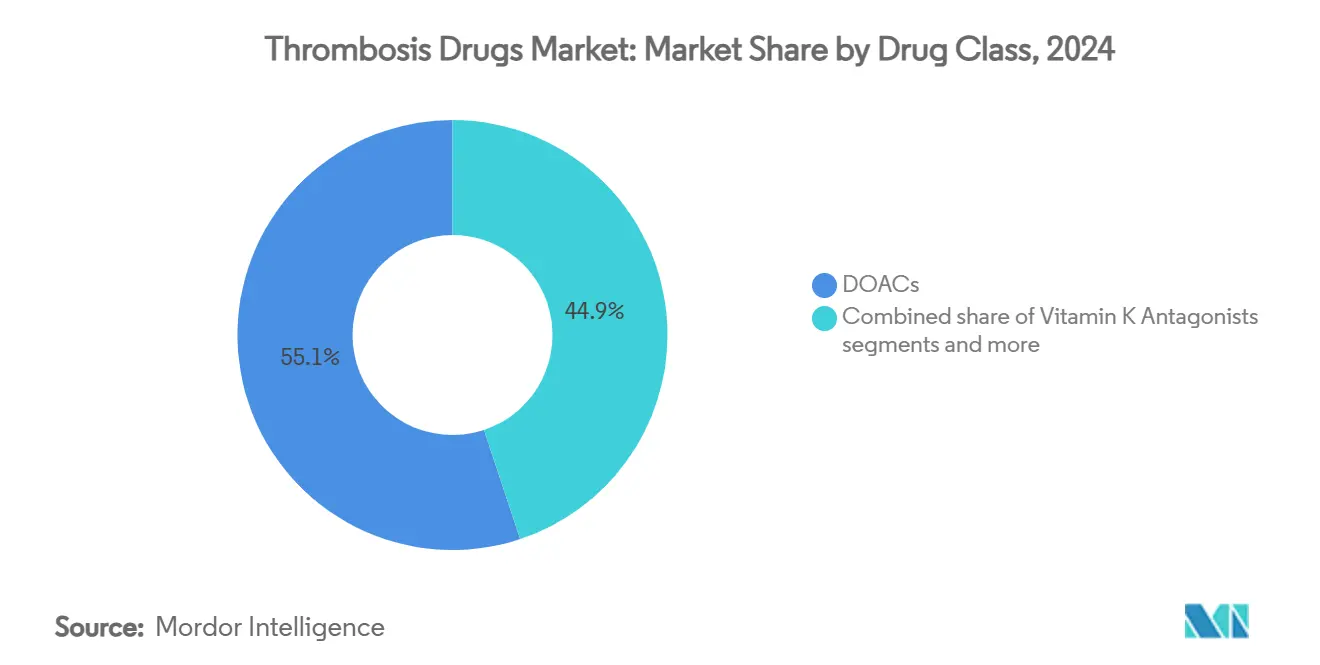
Note: Segment shares of all individual segments available upon report purchase
By Disease Type: DVT leadership against rapid PE growth
Deep-vein thrombosis accounted for 31.81% of thrombosis drugs market size in 2024, driven by guideline-mandated anticoagulation post-orthopedic surgery. Pulmonary embolism is set to expand fastest at 8.43% CAGR, fueled by improved CT angiography diagnostics.
Adoption of Pulmonary Embolism Response Teams (PERTs) standardizes rapid treatment, while cancer-associated thrombosis gains visibility as survival rates rise. Stroke prevention in atrial-fibrillation patients remains a high-value application, especially with Factor XI safety data promising broader eligibility.
By Route of Administration: Oral prevalence with injectable resurgence
Oral therapies represented 67.3% of thrombosis drugs market size in 2024. Long-acting once-daily formulations reinforce adherence, particularly in outpatient atrial-fibrillation management.
Hospitals rely on LMWHs and unfractionated heparin for immediate onset and quick reversal. Pipeline assets such as weekly subcutaneous Factor XI inhibitors may offer an oral-free alternative that merges convenience with rapid titration, giving injectables renewed prominence within the thrombosis drugs market.
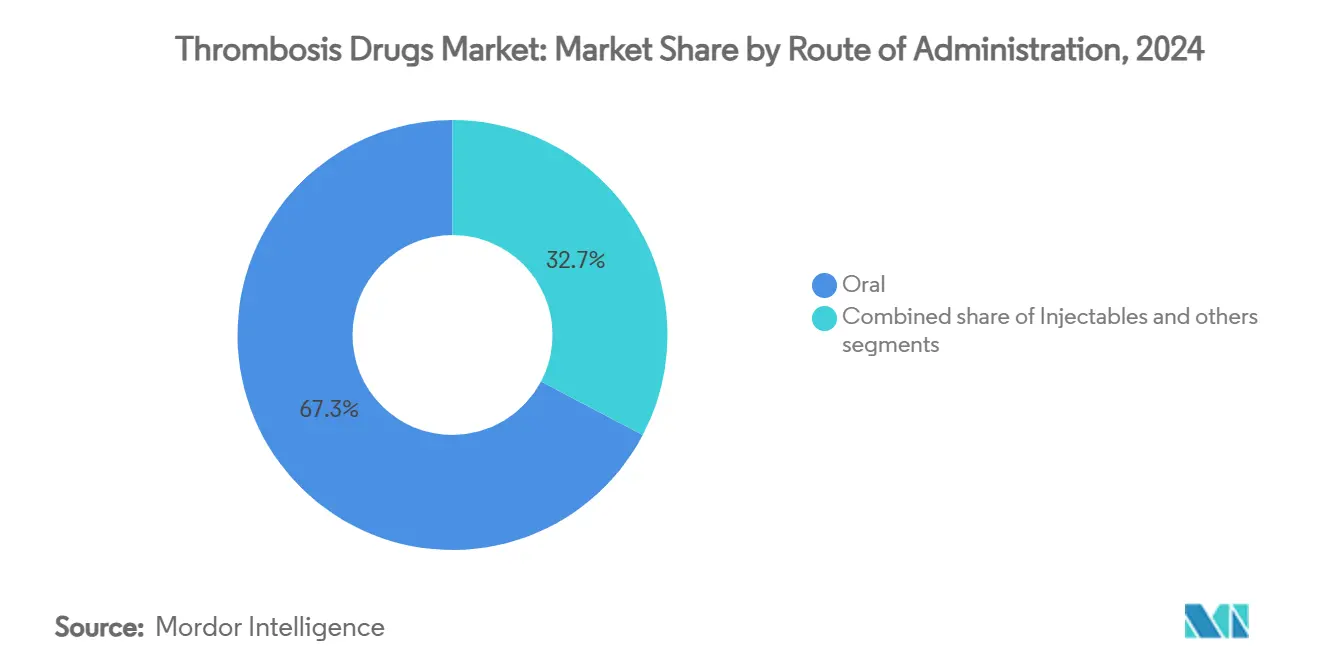
Note: Segment shares of all individual segments available upon report purchase
By Distribution Channel: Hospital lead amid digital expansion
Hospital pharmacies generated 46.8% of value in 2024, tied to acute care initiation. Retail outlets support chronic management, yet online pharmacies are advancing at 8.09% CAGR as telehealth normalizes digital prescriptions.
Direct-to-consumer discount programs bypass traditional benefit managers, and specialty pharmacies integrate adherence apps that transmit dosing data to clinicians. Such hybrid models are reshaping last-mile delivery economics in the thrombosis drugs market.
Geography Analysis
North America’s reimbursement systems and early DOAC adoption anchored 38.2% thrombosis drugs market share in 2024. Federal price negotiations aim to balance affordability with innovation, potentially widening drug access without hampering R&D investments.
Europe maintains harmonized clinical guidelines that speed incorporation of breakthrough agents; the region shows consistent mid-single-digit growth supported by aging demographics.
Asia-Pacific, projected at 7.93% CAGR, benefits from infrastructure upgrades and higher elective-surgery volumes. China’s tiered hospital reform and India’s Ayushman Bharat scheme expand insured cohorts, while Japan’s super-aged society sustains high per-capita anticoagulant use. Latin America and the Middle East & Africa trail but show rising awareness campaigns and imported generics that lower entry barriers, gradually enlarging their footprint in the thrombosis drugs market.
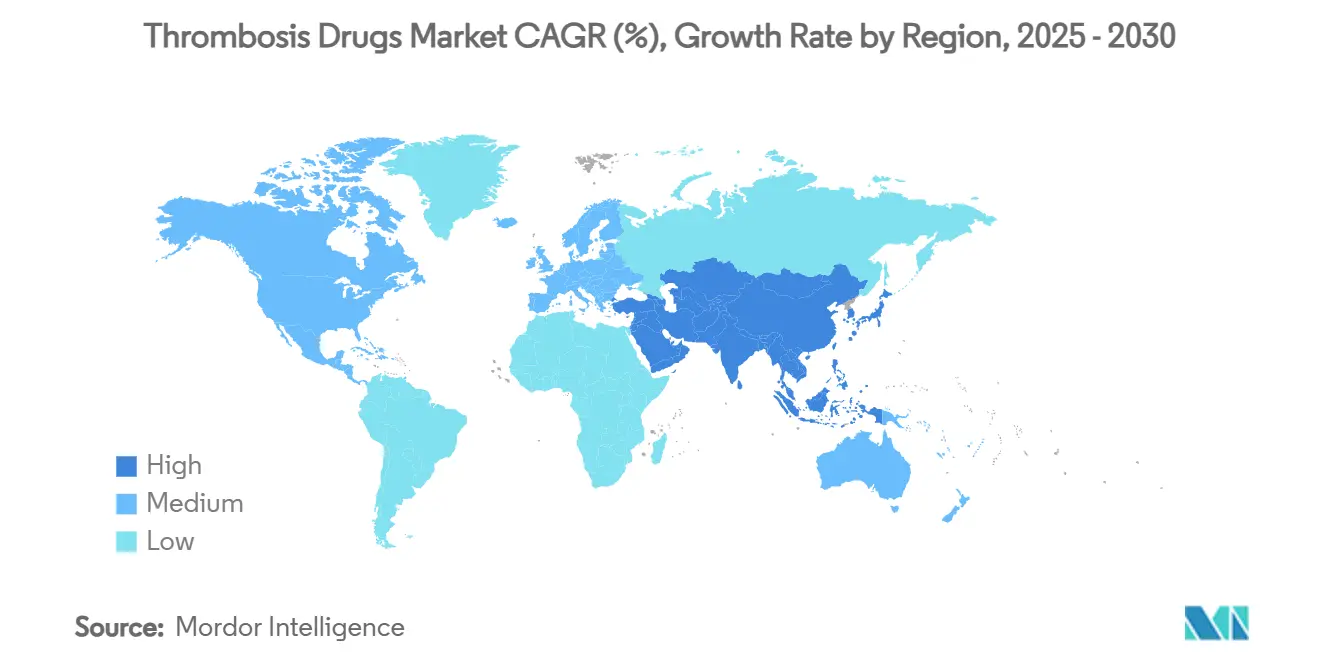
Competitive Landscape
Intellectual-property expiries are tilting power toward pipelines rather than current brands. Bristol Myers Squibb–Pfizer’s Eliquis alliance exemplifies a scale-economies approach, yet its 2028 exclusivity sunset drives the partners to explore next-wave targets. Bayer pivots toward cardiometabolic diversification after seeing Xarelto revenues slide on generic pressure.
Novartis’ acquisition of Anthos Therapeutics positions abelacimab as a flagship entrant into the Factor XI space, while Johnson & Johnson advances milvexian to Phase III in multiple indications. The field witnesses a rising prevalence of strategic collaborations pairing molecule innovation with digital risk-stratification platforms to deepen clinical stickiness.
Generic manufacturers Lupin and Taro capitalize on newly granted approvals, enabling payers to swap to lower-cost options rapidly. Market contenders therefore race to offer differentiated bleeding profiles or bundled care ecosystems, reaffirming that future competitiveness hinges on holistic thrombosis-management solutions rather than drug efficacy alone.
Thrombosis Drugs Industry Leaders
Boehringer Ingelheim GmbH
Johnson & Johnson
Sanofi SA
Pfizer Inc.
Laurus Lab (Aspen Pharmacare Holdings Limited)
- *Disclaimer: Major Players sorted in no particular order
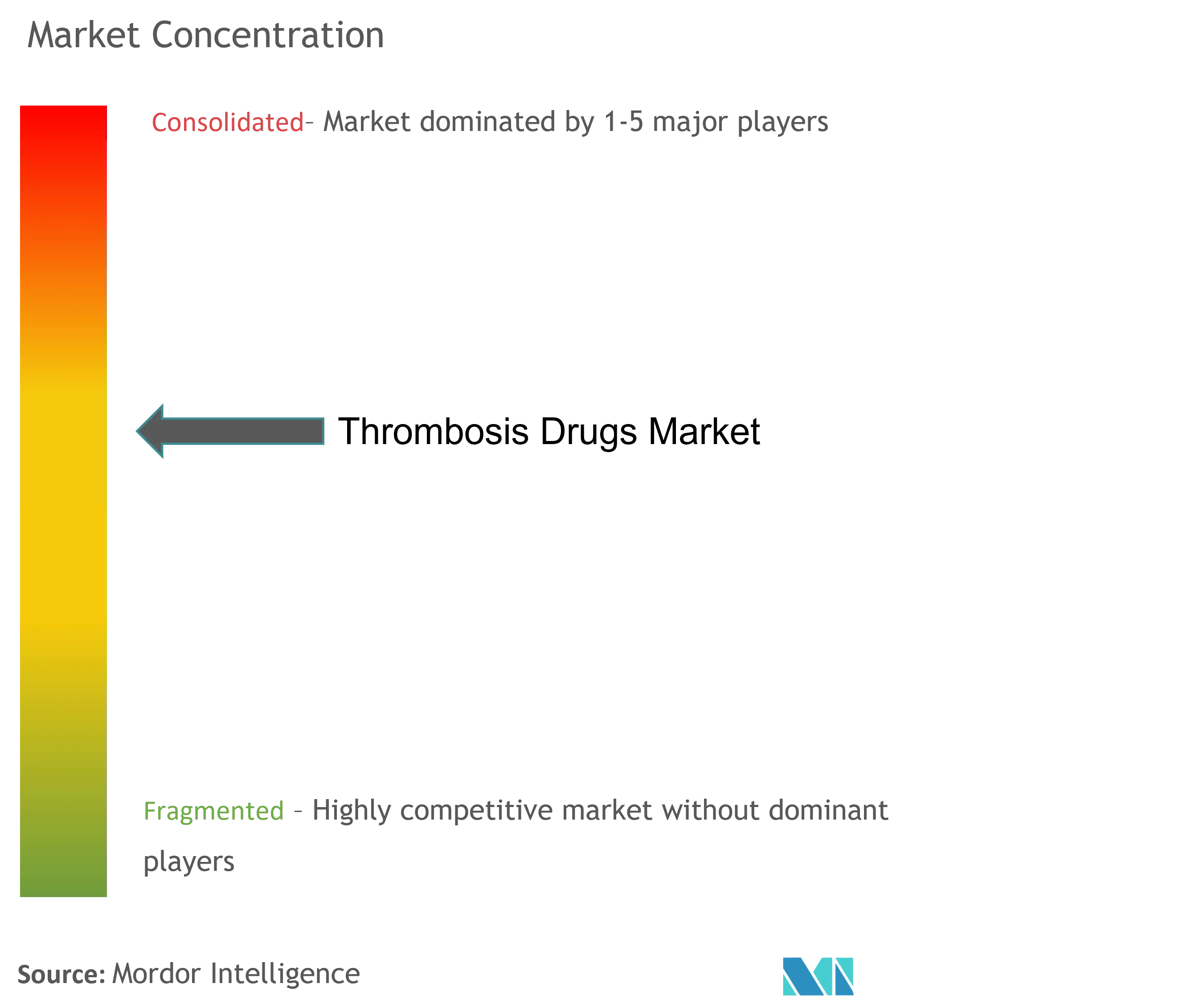


Recent Industry Developments
- July 2025: Bristol Myers Squibb and Pfizer began direct-to-consumer Eliquis sales at 40% discount
- March 2025: FDA cleared first rivaroxaban generics from Lupin and Taro, triggering immediate price competition
Global Thrombosis Drugs Market Report Scope
As per the scope of the report, a thrombus is a blood clot that develops on the inside of the heart or on the walls of blood vessels as a result of the adhesion of blood platelets, proteins, and cells. Thrombosis is considered to be the major source of morbidity and mortality among elderly patients. It has been established that thrombosis is caused due to certain cardiovascular disorders as a result of old age or obesity.
The thrombosis drugs market is segmented by drug class, disease type, distribution channel, and geography. By drug class, the market is segmented as factor Xa Inhibitor, Heparin, P2Y12 Platelet Inhibitor, and other drug classes. By disease type, the market is segmented as pulmonary embolism, atrial fibrillation, deep vein thrombosis, and other disease types. By distribution channel, the market is segmented into hospital pharmacies, retail pharmacies, and online pharmacies. By geography, the market is segmented as North America, Europe, Asia-Pacific, Middle East and Africa, and South America. The market report also covers the estimated market sizes and trends for 17 different countries across major regions globally. The report offers the value (in USD) for the above segments.
| Direct Oral Anticoagulants (DOACs) |
| Heparin & Low-Molecular-Weight Heparin |
| Vitamin K Antagonists |
| Thrombolytics / Fibrinolytics |
| P2Y12 Platelet Inhibitors |
| Factor XI / XII Inhibitors (emerging) |
| Others |
| Deep Vein Thrombosis |
| Pulmonary Embolism |
| Atrial Fibrillation |
| Peripheral Arterial Disease |
| Stroke & Transient Ischemic Attack |
| Others |
| Oral |
| Injectable |
| Topical |
| Hospital Pharmacies |
| Retail Pharmacies |
| Online Pharmacies |
| Mail-Order Pharmacies |
| North America | United States |
| Canada | |
| Mexico | |
| Europe | Germany |
| United Kingdom | |
| France | |
| Italy | |
| Spain | |
| Rest of Europe | |
| Asia-Pacific | China |
| India | |
| Japan | |
| South Korea | |
| Australia | |
| Rest of Asia-Pacific | |
| South America | Brazil |
| Argentina | |
| Rest of South America | |
| Middle East and Africa | GCC |
| South Africa | |
| Rest of Middle East and Africa |
| By Drug Class (Value) | Direct Oral Anticoagulants (DOACs) | |
| Heparin & Low-Molecular-Weight Heparin | ||
| Vitamin K Antagonists | ||
| Thrombolytics / Fibrinolytics | ||
| P2Y12 Platelet Inhibitors | ||
| Factor XI / XII Inhibitors (emerging) | ||
| Others | ||
| By Disease Type (Value) | Deep Vein Thrombosis | |
| Pulmonary Embolism | ||
| Atrial Fibrillation | ||
| Peripheral Arterial Disease | ||
| Stroke & Transient Ischemic Attack | ||
| Others | ||
| By Route of Administration (Value) | Oral | |
| Injectable | ||
| Topical | ||
| By Distribution Channel (Value) | Hospital Pharmacies | |
| Retail Pharmacies | ||
| Online Pharmacies | ||
| Mail-Order Pharmacies | ||
| By Geography (Value) | North America | United States |
| Canada | ||
| Mexico | ||
| Europe | Germany | |
| United Kingdom | ||
| France | ||
| Italy | ||
| Spain | ||
| Rest of Europe | ||
| Asia-Pacific | China | |
| India | ||
| Japan | ||
| South Korea | ||
| Australia | ||
| Rest of Asia-Pacific | ||
| South America | Brazil | |
| Argentina | ||
| Rest of South America | ||
| Middle East and Africa | GCC | |
| South Africa | ||
| Rest of Middle East and Africa | ||


Key Questions Answered in the Report
What is the current size of the thrombosis drugs market?
The thrombosis drugs market size is USD 26.14 billion in 2025.
Which drug class leads the thrombosis drugs market?
Direct oral anticoagulants hold 55.1% market share, making them the leading class.
How fast will Factor XI inhibitors grow?
Factor XI inhibitors are forecast to post an 8.61% CAGR between 2025 and 2030.
Why is pulmonary embolism the fastest-growing disease segment?
Improved CT angiography diagnostics and widespread thromboprophylaxis protocols are accelerating treatment volumes.
Page last updated on:
